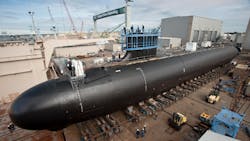Navy orders nine new Virginia-class submarines with additional missile tubes for enhanced undersea warfare
WASHINGTON – U.S. Navy undersea warfare experts are ordering nine new Virginia-class fast-attack submarines -- most of them with additional vertical-launch missile tubes -- under terms of a $22.2 million 10-year contract modification announced Monday.
Officials of the Naval Sea Systems Command in Washington are asking General Dynamics Electric Boat in Groton, Conn., to build nine Virginia-class submarines -- eight with the Virginia Payload Module (VPM). General Dynamics Electric Boat is a subsidiary of General Dynamics Corp.
This order covers building the fifth block of Virginia-class submarines by General Dynamics and major subcontractor Huntington Ingalls Industries' Newport News Shipbuilding division in Newport News, Va.
The Virginia Payload Module is a mid-body section on the centerline of the submarine that contains four additional Virginia Payload Tubes that replace single-purpose cruise missile launch tubes.
The VPM increases the overall length of the submarine, and enables the Virginia-class submarine to carry as many as 28 additional Tomahawk cruise missiles, similar munitions, or unmanned underwater vehicles (UUVs). Each of the four VPM tubes can fit as many as seven Tomahawk missiles.
Compared to their predecessors such as the U.S. Seawolf- and Los Angeles-class attack submarines, the Virginia class boats offer several electronic, electro-optical, and propulsion innovations not previously built into other submarine classes.
The Virginia class, for the first time, has no opening in its pressure hull through which a conventional periscope raises and lowers. Instead, the nation's newest submarine class have photonics masts with high-resolution daylight cameras, light-intensification and infrared sensors, an infrared laser rangefinder, and special electronics to intercept enemy communications.
Instead of passing through an opening in the boat's pressure hull, which can create a weak spot in combat, signals from photonics mast sensors enter the submarine via optical fiber for signal processing in the boat's command center.
Related: Rough waters ahead for Navy new Columbia-class ballistic missile submarine construction
In addition, the Virginia class also has improved sonar systems and electromagnetic signature reduction to reduce the possibility of enemy detection. The boat has a bow-mounted spherical active and passive sonar array, a wide aperture lightweight fiber optic sonar array, and two high-frequency active sonars in the sail and keel.
Instead of traditional bladed propellers, the Virginia class has pump-jet propulsors to reduce the risks of cavitation and enable quieter operation than traditional propellers allow. The boat also has fiber-optic fly-by-wire ship control, AN/BYG-1 combat system, and nine-man lockout chamber for covert insertion of Special Operations forces.
Virginia-class submarines are designed for anti-submarine and surface ship warfare and special operations support, as well as intelligence, surveillance, and reconnaissance (ISR). They are to replace legacy Los Angeles-class attack submarines as the older boats are retired. Los Angeles-class subs have been at sea since the 1970s.
Electric Boat and Newport News Shipbuilding already have delivered 19 Virginia-class submarines to the Navy. Nine additional submarines are under construction.
Without the Virginia Payload Module, Virginia-class submarines displace 7,800 tons, are 377 feet long, and 34 feet in diameter. They can travel faster than 25 knots and dive deeper than 800 feet. They carry Mark 48 advanced capability torpedoes, Tomahawk land-attack missiles, and unmanned underwater vehicles (UUVs).
This contract modification has an option for one additional submarine with the Virginia Payload Module, which could increase its value to $24.1 billion. General Dynamics and Newport News Shipbuilding will do the work in Newport News, Va.; Groton, Conn.; Quonset Point, R.I.; Sunnyvale, Calif.; Norfolk, Va.; Bethlehem, Pa.; and Annapolis, Md., and should be finished by August 2029.
For more information contact General Dynamics Electric Boat online at www.gdeb.com, Newport News Shipbuilding at https://nns.huntingtoningalls.com, or Naval Sea Systems Command at www.navsea.navy.mil.
About the Author
John Keller
Editor-in-Chief
John Keller is the Editor-in-Chief, Military & Aerospace Electronics Magazine--provides extensive coverage and analysis of enabling electronics and optoelectronic technologies in military, space and commercial aviation applications. John has been a member of the Military & Aerospace Electronics staff since 1989 and chief editor since 1995.

